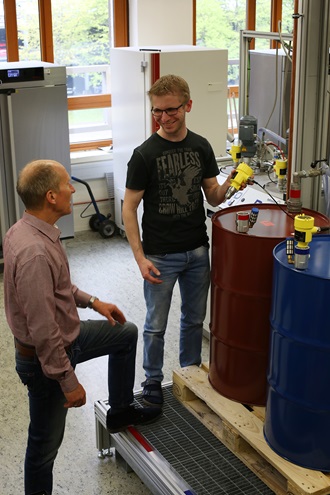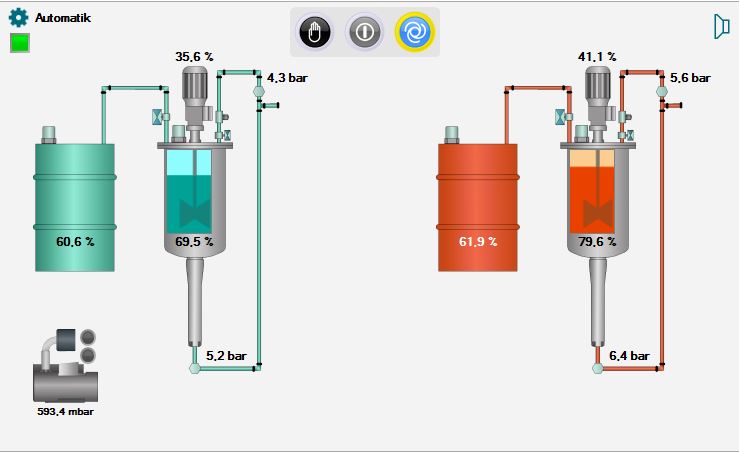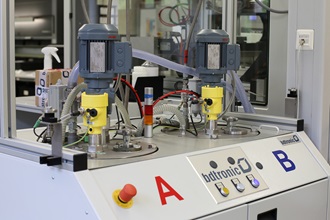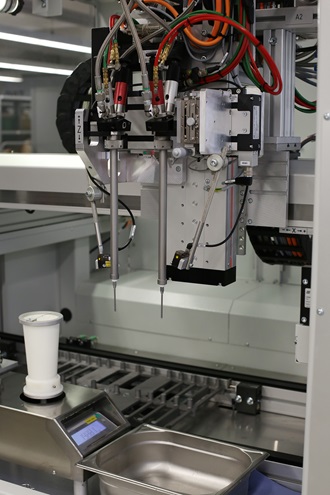Relying on our own measurement technology – level measurement of silicone gel |
The electronics manufacturing department in Schiltach is responsible for making the intelligent inner 'brains' of all VEGA products. Every year more than one million printed circuit boards for sensors and signal conditioning instruments are produced there. Most of them end up in the electronics modules of the sensors. To guarantee a long service life under often harsh operating conditions, they are sealed and potted with a special 2-component silicone gel. But what level measurement technology is used in the raw material storage drums to ensure the continuous operation of the potting machine? It’s the perfect application for the radar sensor VEGAPULS 64 with 80 GHz technology.
Marcel Schrempp, head of electronics manufacturing at VEGA, is very satisfied with these compact radar sensors. After all, they measure the level in two 200-liter storage drums extremely reliably. These drums contain the liquid components of the potting compound with the illustrious name of 'Sylgard® 527', manufactured by Dow Corning.
It belongs to a group of products that are very difficult to measure with radar technology: electrically non-conductive, with a low dielectric constant of only 2.85. But it is precisely these properties that are needed to ensure that the hardened potting compound injected into the electronics module protects the highly integrated electronics from moisture, leakage currents and voltage flashovers.
In daily operation the sensors, with their small ¾" threaded fitting, measure through a narrow adapter fitting down into the barrel. This special focusing and size is currently offered on the market only by VEGAPULS 64 - thanks to its high transmission frequency of 80 GHz. The measured value is visualized at the control panel of the potting machine, thus informing the operator when he has to schedule a drum change.
This is of course also possible via a smartphone and App utilising new Bluetooth capabilities of the sensors.
Exchanging the drum is very easy: Lift out the sensor from the adapter, unscrew the adapter from the drum, close the empty drums with plugs and place two new, full drums at the dispensing point, then refit the adapter and sensor. Gone are the days when the level was measured by capacitive probes! Although this was an effective solution in terms of measurement technology, the probes first had to be disconnected electrically each time the drum was exchanged. Then unscrewed and pulled out of the drum in their entire length. It was comparatively large amount of work and could get messy, with the silicone compound dripping from the probe during change-over.
But now to the process: how does the silicone gel get from the drums to the electronics cups? A vacuum pump sucks exactly the amount that is needed out of the storage drums to fill two smaller intermediate containers on the potting machine itself. Each has a capacity of approximately 36 liters.
Filling station with the two static mixers in the middle of the picture. The pressure is measured by four VEGABAR 17 sensors.
These containers are also level monitored – with built-in VEGACAL 63 capacitive measuring probes. Two eccentric screw pumps, which build up the pressure of approx. 3.5 bar required for filling, take over the extraction from these containers. The material goes through a static mixer and then through the filling nozzles into the electronics cup. The static mixer is nothing more than a piece of pipe with a fixed spiral through which both components are pressed and mixed together.
The required quantity flows time-controlled in 30... 60 seconds into the respective electronics.
On a normal working day, approx. 100 litres of the silicone runs through this system. This means drums are exchanged around every four days and the machine fills around 250,000 electronics modules a year. Only a few hours after mixing, the gel hardens and achieves the desired firmness. This is exactly the property that protects the sensor electronics from vibration in rough day-to-day use.
Related products
Export this article
Download as PDFShare this article
Comments ({{comments.length}})
{{getCommentAuthor(comment, "Anonymous")}} {{comment.timestamp | date : "dd.MM.yyyy HH:mm" }}
{{comment.comment}}





